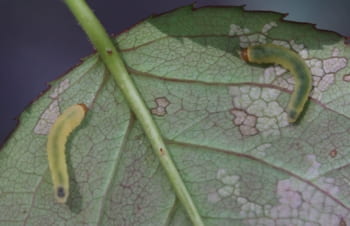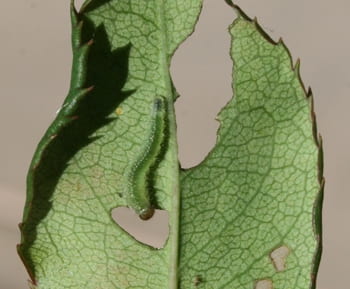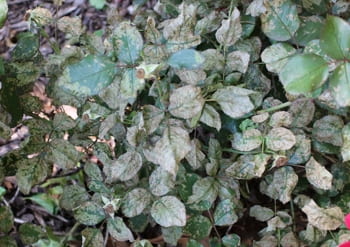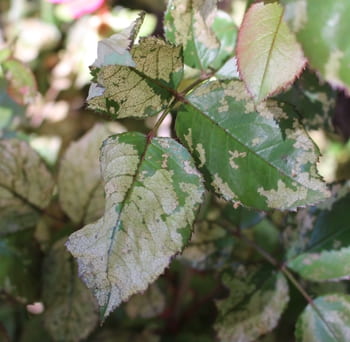–by Raymond Cloyd, Horticultural Entomologist
We have received numerous inquiries associated with insects feeding on the leaves of rose plants. The insects are sawflies and there are at least two species that attack roses this time of year: the rose slug, Endelomyia aethiops, and the bristly rose slug, Cladius difformis. Rose slugs are the immature or larval stage that eventually becomes a black to yellow-colored adult, which resembles a wasp.
Rose sawfly females create openings or slits along the edges of rose leaves with their saw-like egg laying device (ovipositor) and insert eggs. Larvae emerge from the eggs and resemble small slugs. Larvae are approximately 1/2 of an inch long when full-grown and yellow-green, with an orange head (Figure 1).

Figure 1. Rose Sawfly Larvae Feeding on Rose Leaf (Raymond Cloyd, Kansas State University)
The larvae fall onto the soil surface and pupate. Rose slugs overwinter as pupae in earthen cells that are created by the larvae. Bristly rose slug larvae are pale-green and approximately 1/2 to 3/4 of an inch in length. The body is covered with bristle-like hairs (Figure 2). Both species typically have one generation per year in Kansas.

Figure 2. Bristly Rose Slug Larva Feeding On Leaf Underside of Rose (Raymond Cloyd, Kansas State University)
Rose slug larvae feed on the underside of rose leaves causing the leaves to appear skeletonized (Figures 3 and 4). The larvae create notches or holes on the leaf margins. Bristly rose slug larvae feed on the underside of rose leaves causing leaves to appear skeletonized. However, the larvae create larger holes than the rose slug.

Figure 3. Damage on Rose Plant Caused By Rose Slug Larvae Feeding (Raymond Cloyd, Kansas State University

Figure 4. Damage on Rose Leaf Caused By Rose Slug Larvae Feeding (Author-Raymond Cloyd, Kansas State University)
Small infestations of either the rose sawfly or bristly rose slug can be dealt with by removing the larvae by hand and placing into a container of soapy water. A high pressure water spray will quickly dislodge sawfly larvae from rose plants and they will not crawl back onto rose plants. There are a number of contact insecticides containing various active ingredients that are effective in managing populations of both sawflies. Sawflies are not caterpillars. Consequently, the bacterium, Bacillus thuringiensis subsp. kurstaki, which is the active ingredient in various products (e.g. Dipel®) has no activity on sawflies because the insecticide is only effective against caterpillars.